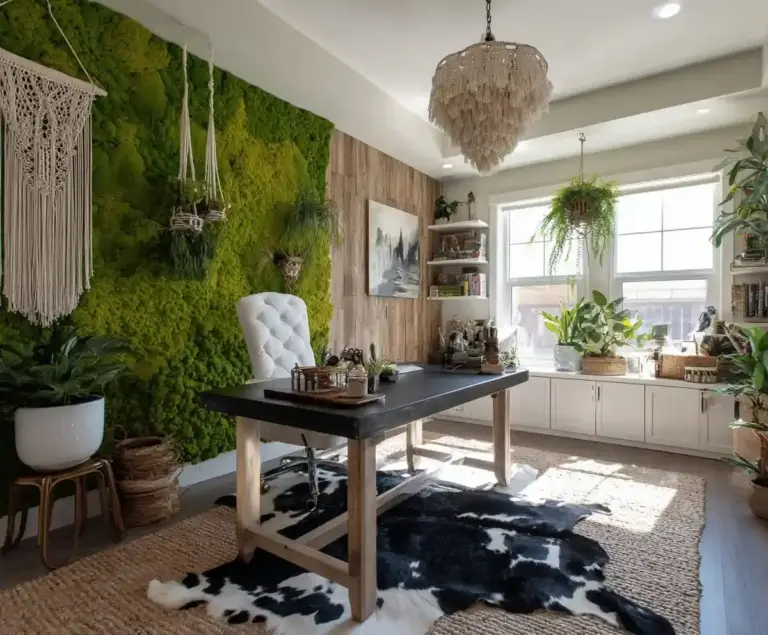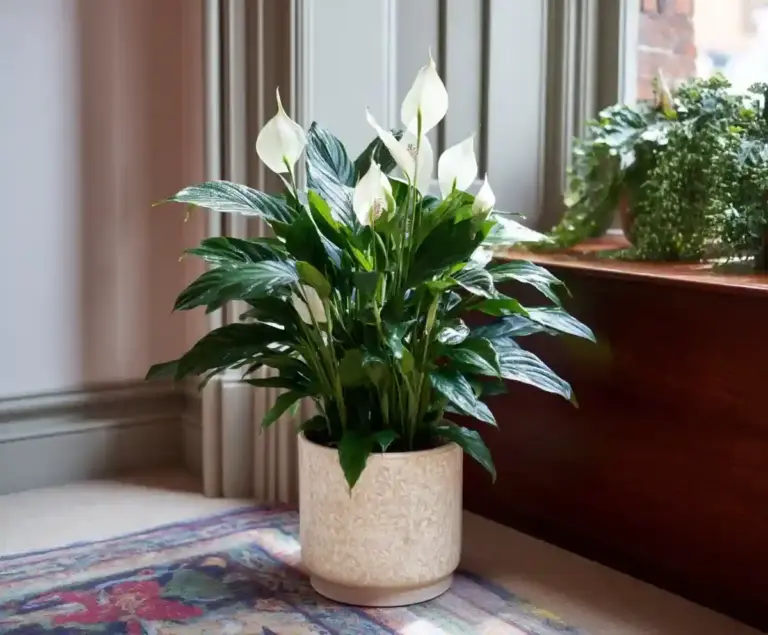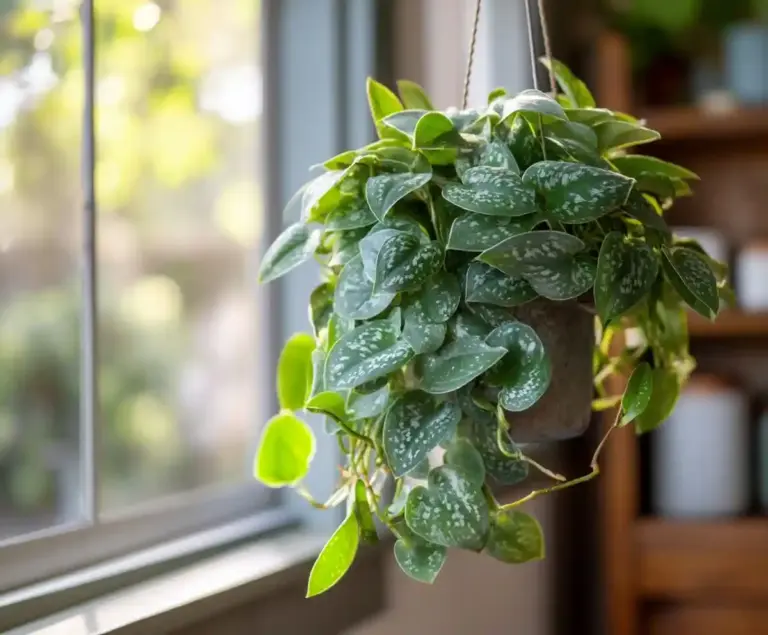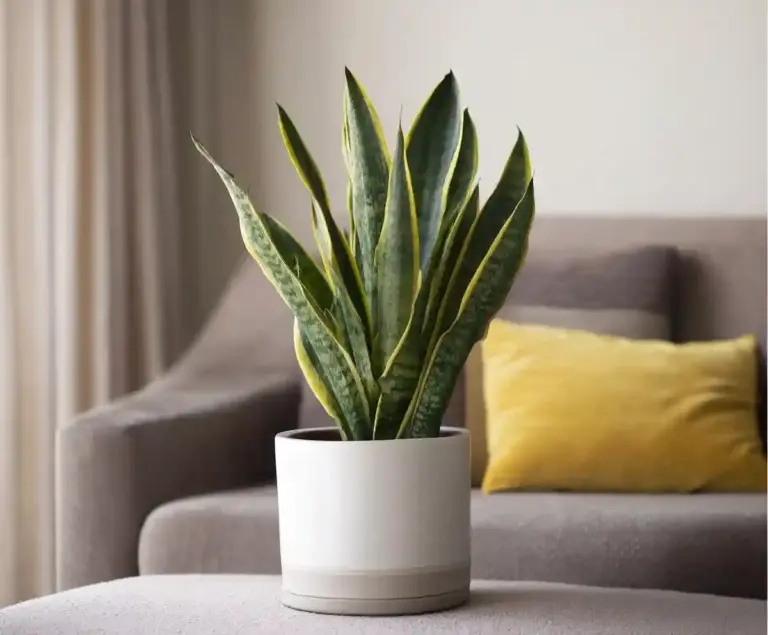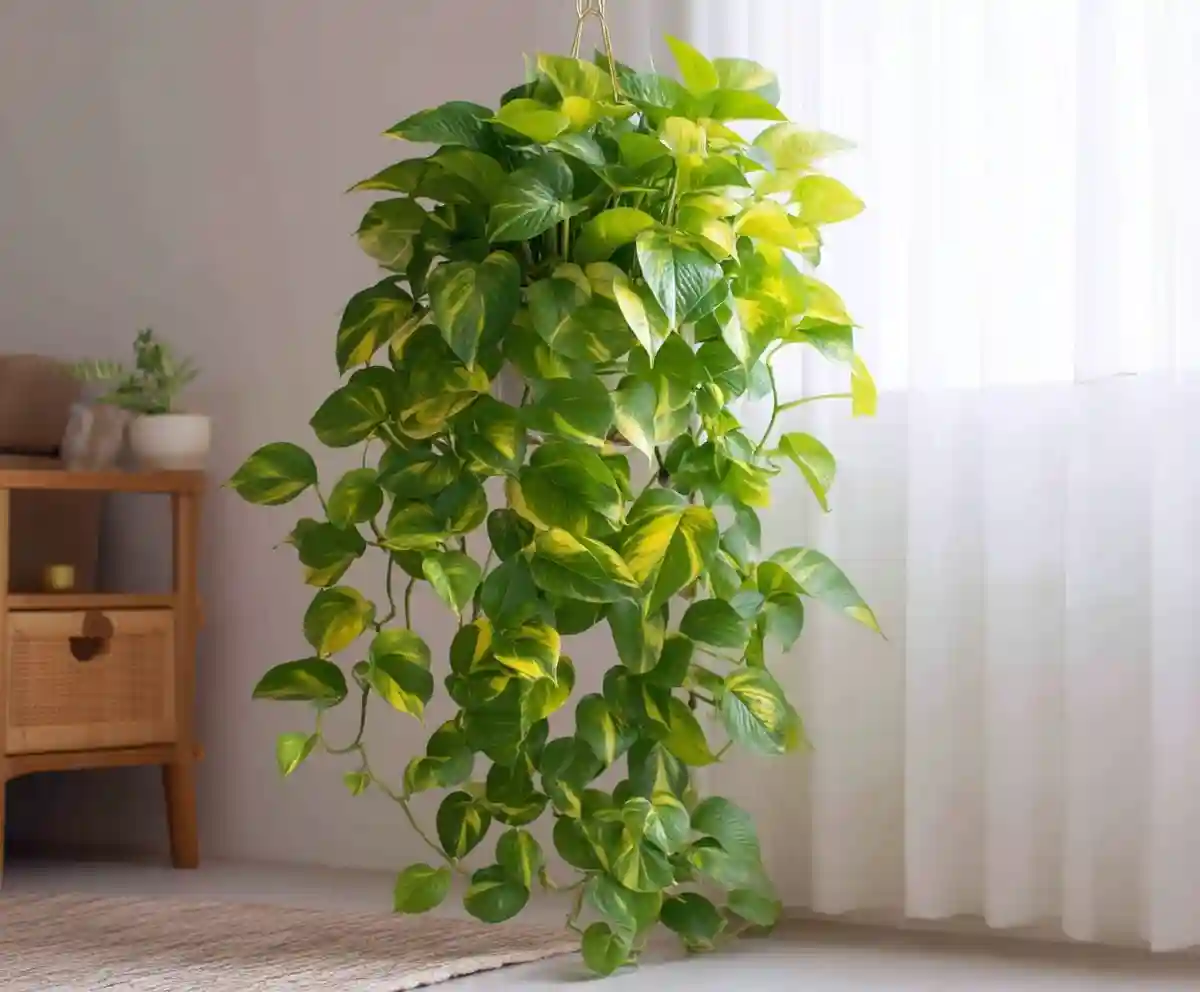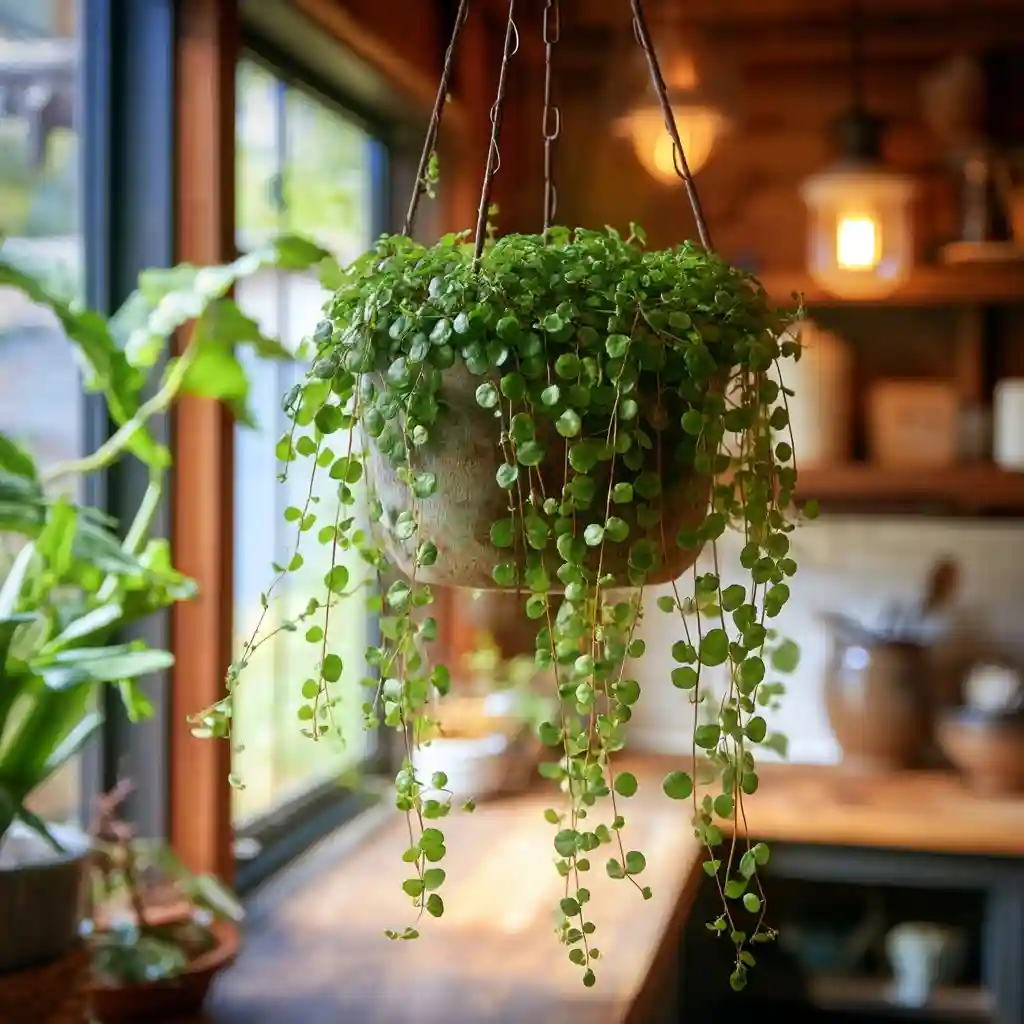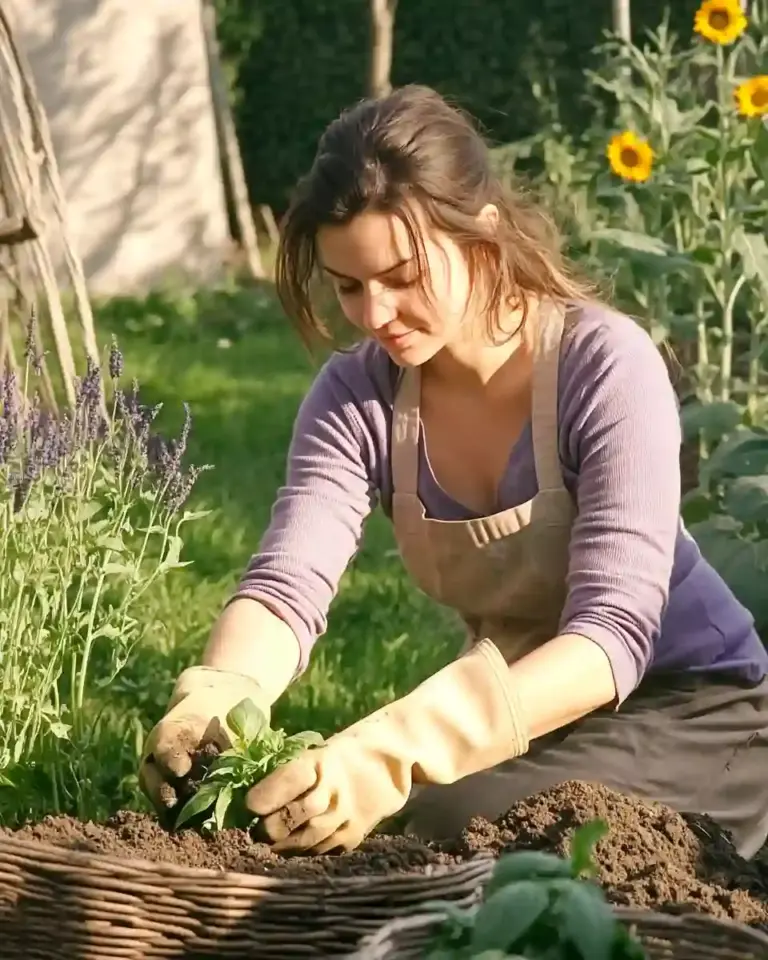Hanging plants bring movement, color, and freshness to indoor spaces in a way that potted plants on tables or shelves simply can’t match. With their trailing stems and cascading leaves, they make use of vertical space, turning blank walls or empty corners into lush, green features. Whether you live in a small apartment or a spacious home, incorporating hanging plants adds a natural softness and a touch of creativity to your rooms.
Beyond their beauty, these plants often help improve air quality and create a calming atmosphere. From leafy ferns to trailing succulents, there’s a perfect variety for every lighting condition and care level. In this guide, we’ll highlight some of the best options so you can choose the right ones to brighten your living space.
Table of Contents
1. Baby’s Tears
Baby’s Tears (Pilea depressa) is a charming choice for anyone who wants a delicate, fast-growing option among hanging plants. Its tiny, round leaves spill over containers like a soft green curtain, creating a full, textured look.
This plant thrives in bright, indirect light but can tolerate moderate light as well. Keep the soil consistently moist, as Baby’s Tears dislike drying out. Because of their trailing growth habit, they look especially appealing in shallow hanging baskets or small planters placed on high shelves.
If you’re aiming for lush coverage in a compact space, this variety is a dependable and low-maintenance pick.
2. Boston Fern
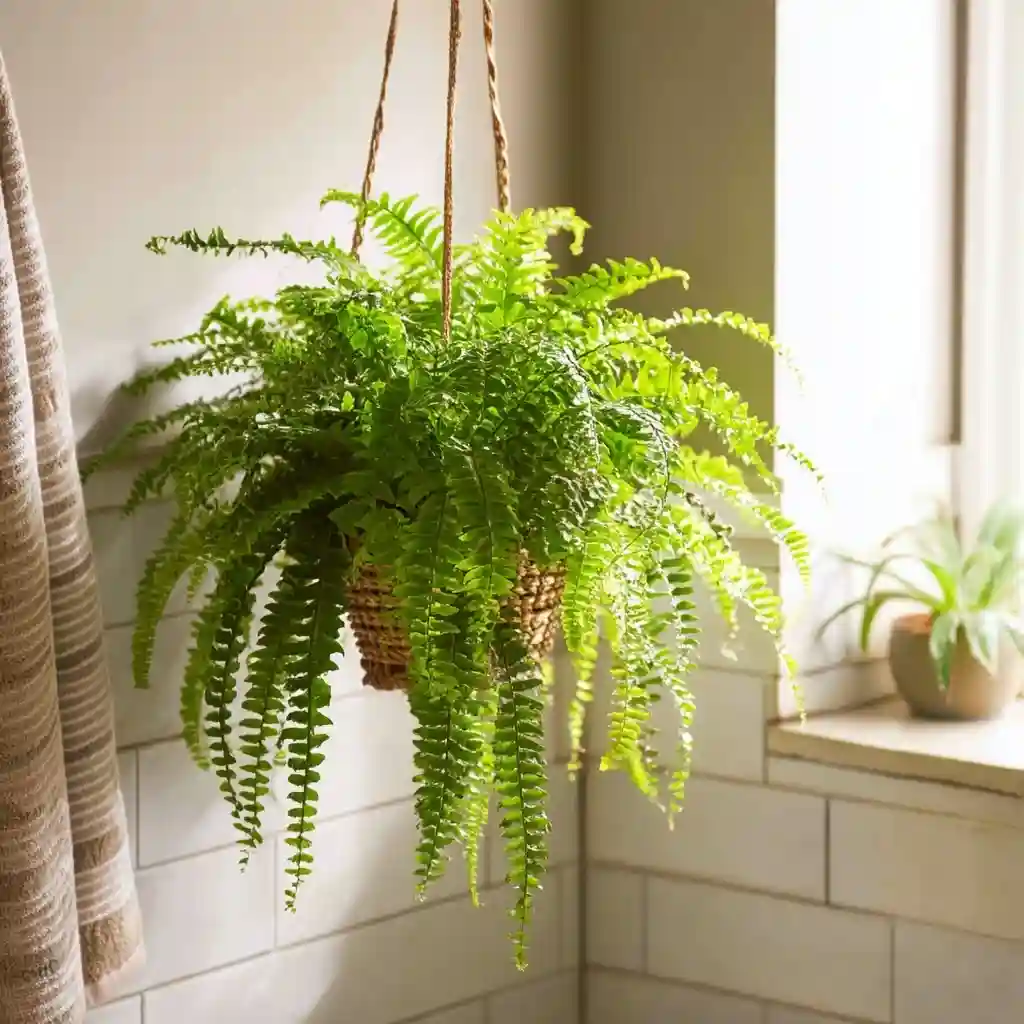
The Boston Fern (Nephrolepis exaltata) is a classic favorite among hanging plants, known for its feathery, arching fronds that bring instant lushness to any room. Its dense foliage creates a waterfall effect, making it perfect for filling vertical spaces with greenery.
Boston ferns love humidity and bright, indirect light. They thrive in kitchens, bathrooms, or any area where the air stays slightly moist. To keep the fronds from drying out, mist them regularly or place a humidifier nearby.
With proper care, this plant becomes a dramatic focal point, softening interiors with its vibrant, airy texture.
3. Burro’s Tail
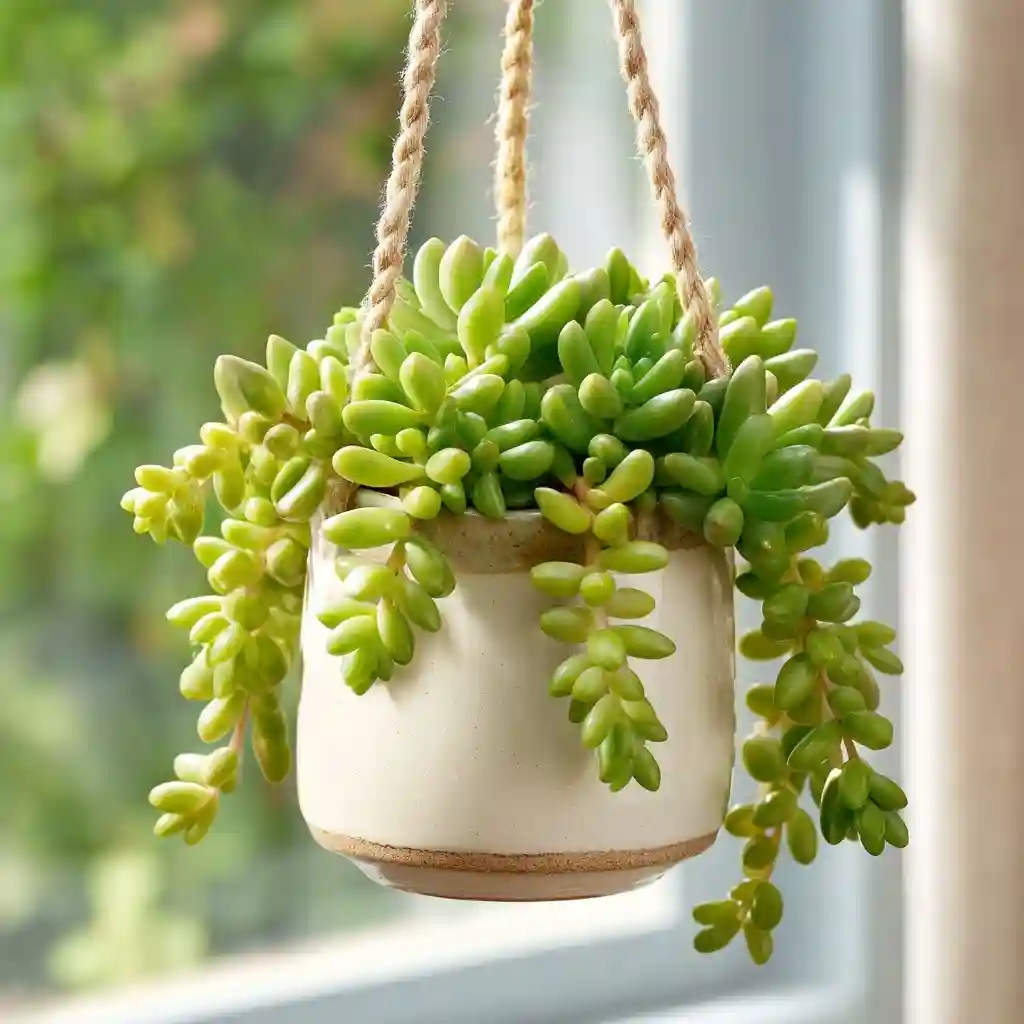
Burro’s Tail (Sedum morganianum) is a standout succulent that earns attention with its thick, ropelike stems covered in plump, teardrop-shaped leaves. As one of the more unique hanging plants, it adds a striking texture and sculptural quality to any room.
This plant prefers bright, indirect light but can handle some direct sun if acclimated slowly. Water sparingly—allow the soil to dry completely between waterings, as overwatering can cause the leaves to drop.
Because of its trailing growth and cascading form, Burro’s Tail looks especially beautiful in hanging baskets placed near windows, where its silvery-green foliage can catch the light.
4. English Ivy
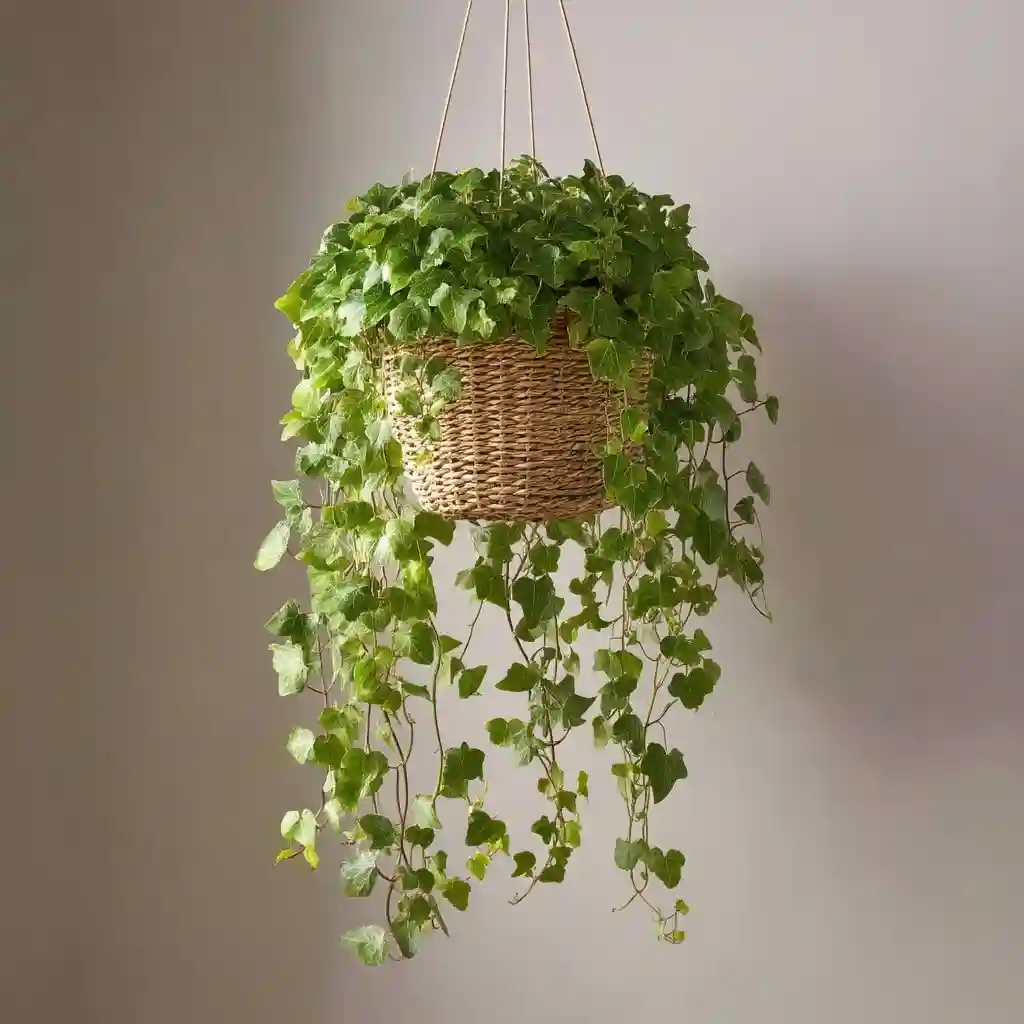
English Ivy (Hedera helix) is a versatile option among hanging plants, admired for its glossy leaves and trailing vines that adapt beautifully to both classic and modern interiors. With its ability to climb or cascade, it’s equally suited for hanging baskets, wall planters, or tall shelves.
This plant grows best in bright, indirect light, though it can tolerate lower light conditions. Keep the soil evenly moist, but avoid waterlogging. English Ivy also comes in a variety of leaf shapes and colors, from solid green to variegated patterns, allowing you to match it with your décor.
Its elegant drape makes it a timeless favorite for filling vertical spaces with greenery.
5. Spider Plant
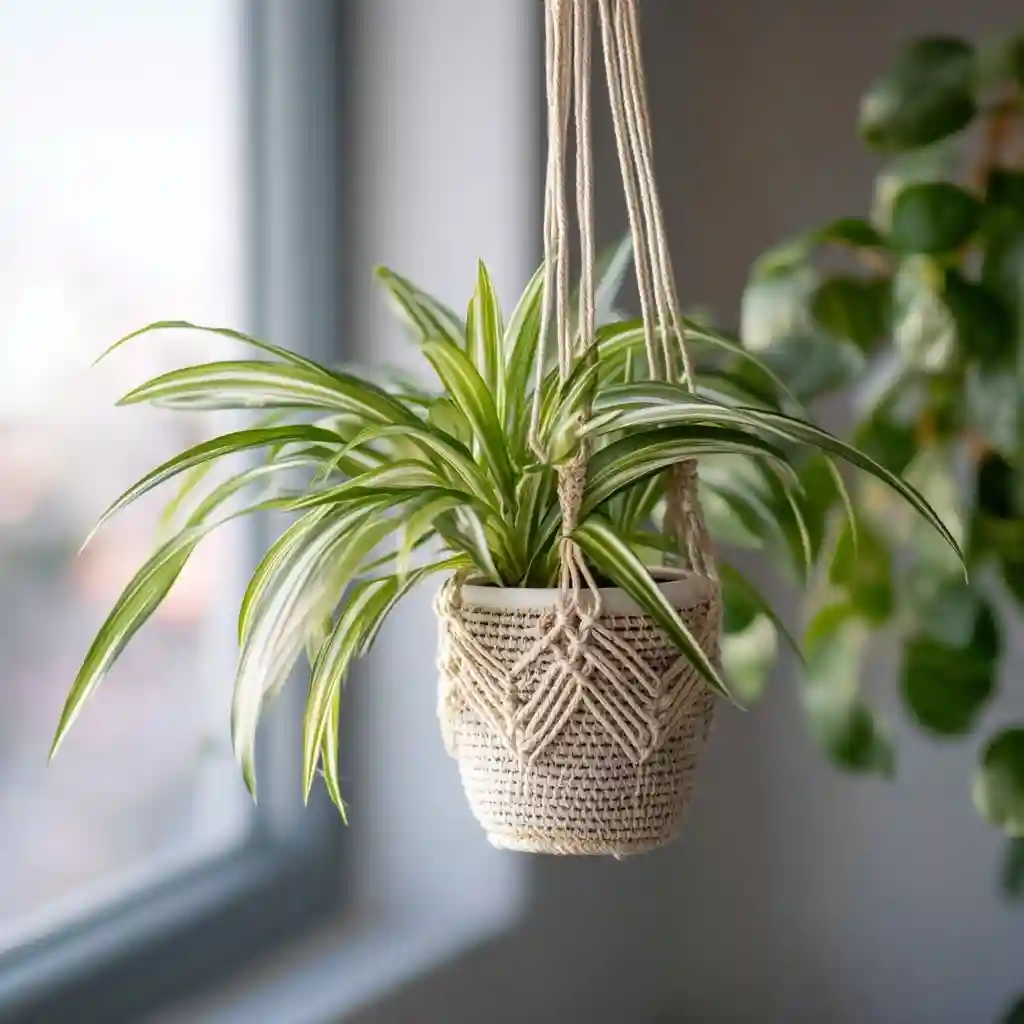
The Spider Plant (Chlorophytum comosum) is one of the most popular hanging plants thanks to its graceful, arching leaves and cascading stems of baby plantlets. Its fountain-like shape adds a vibrant, lively touch to any indoor space.
Spider plants thrive in bright, indirect light but can adapt to moderate light conditions. Water them when the top inch of soil feels dry, and trim off any brown tips to keep the foliage looking fresh.
One of its best features is how easily it propagates—the dangling plantlets can be snipped off and rooted to grow new plants, making it a fun and rewarding choice for beginners.
6. Arrowhead Vine

Arrowhead Vine (Syngonium podophyllum) is a tropical favorite that stands out with its large, heart-shaped leaves. Its trailing vines make it a beautiful option for hanging baskets, while its bold foliage adds a splash of green—or even pink and burgundy, depending on the variety—to indoor spaces.
This plant prefers bright, indirect light and consistent moisture, though it will tolerate lower light levels. Because it thrives in humidity, it’s a great choice for kitchens or bathrooms.
Keep in mind that Arrowhead Vine is toxic to pets, so it’s best placed out of reach if you have cats or dogs at home.
7. Bird’s Nest Fern
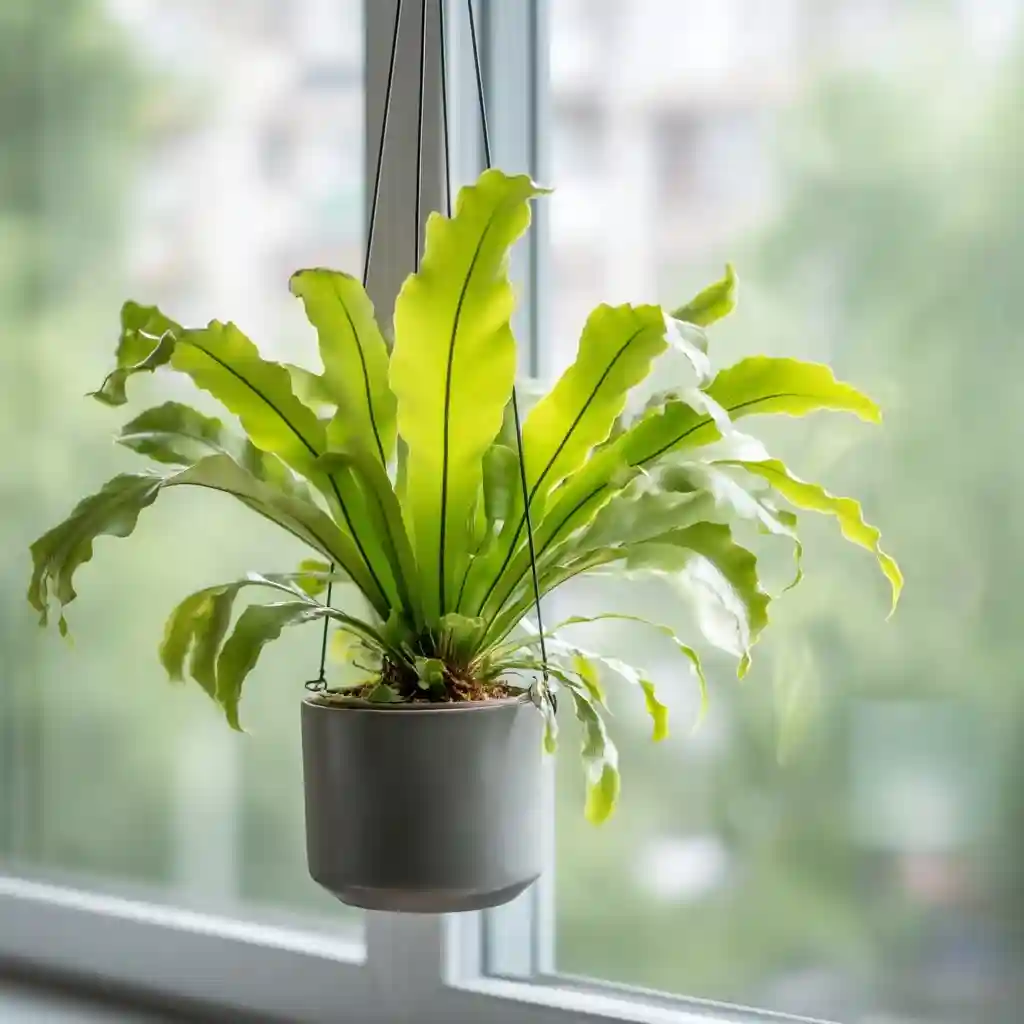
Bird’s Nest Fern (Asplenium nidus) brings a modern, sculptural flair to indoor spaces. Its wide, wavy fronds form a rosette shape that looks striking when allowed to spill gently from a hanging planter. The glossy green leaves add a fresh, tropical feel to any room.
This fern thrives in bright, indirect light but should be kept out of direct sun, which can scorch its leaves. It enjoys high humidity, making it well-suited to bathrooms or near a humidifier. Water the soil when the top layer starts to dry, and avoid pouring water directly into the crown to prevent rot.
Its architectural look makes it a natural statement piece among hanging plants.
8. Pothos
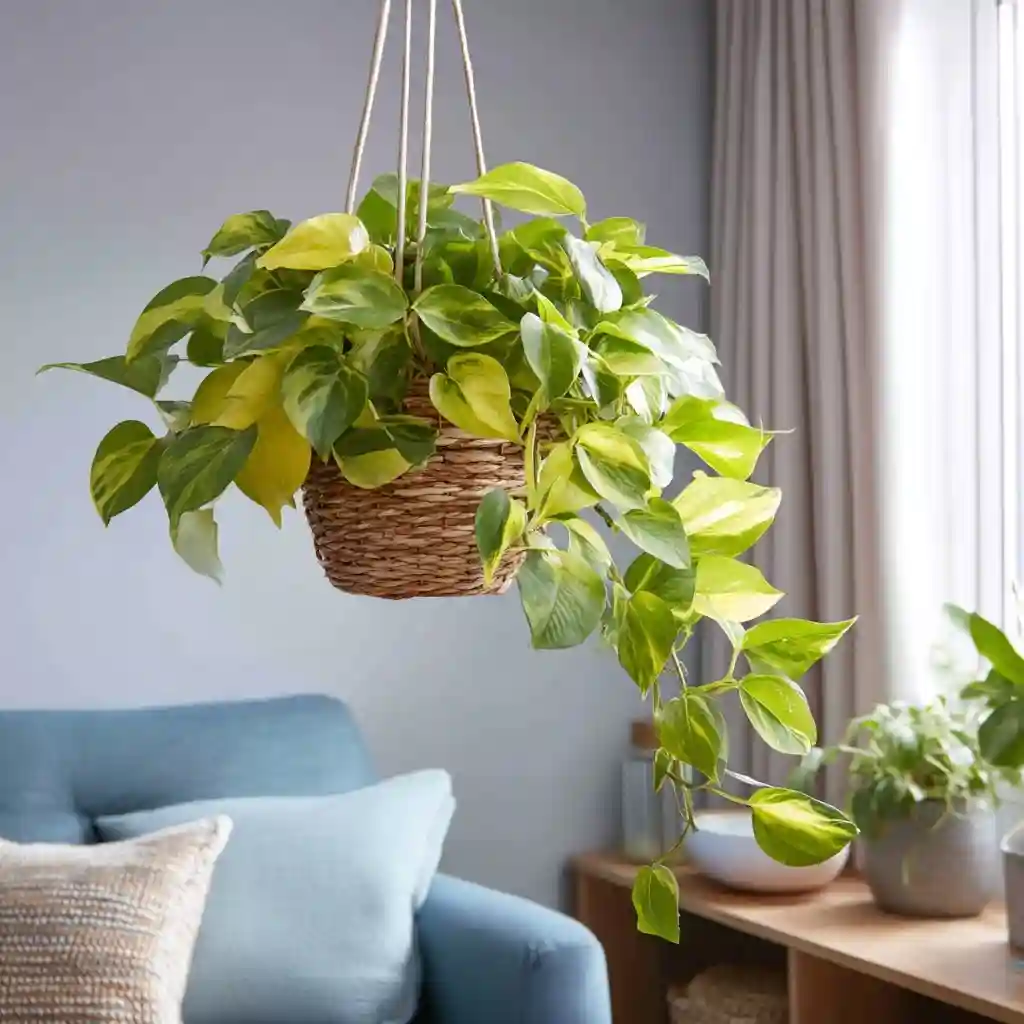
Pothos (Epipremnum aureum) is one of the easiest and most adaptable hanging plants you can grow. Its long, trailing stems and heart-shaped leaves make it a classic choice for adding greenery to ceilings, shelves, or wall hooks. Varieties such as golden pothos or variegated pothos offer eye-catching patterns of yellow, white, or green.
This plant tolerates a wide range of light conditions, though it looks its best in bright, indirect light. Allow the soil to dry slightly between waterings, as pothos dislike being constantly wet.
Because of its low-maintenance nature, fast growth, and versatility, pothos is often considered the perfect beginner’s hanging plant.
9. Heartleaf Philodendron
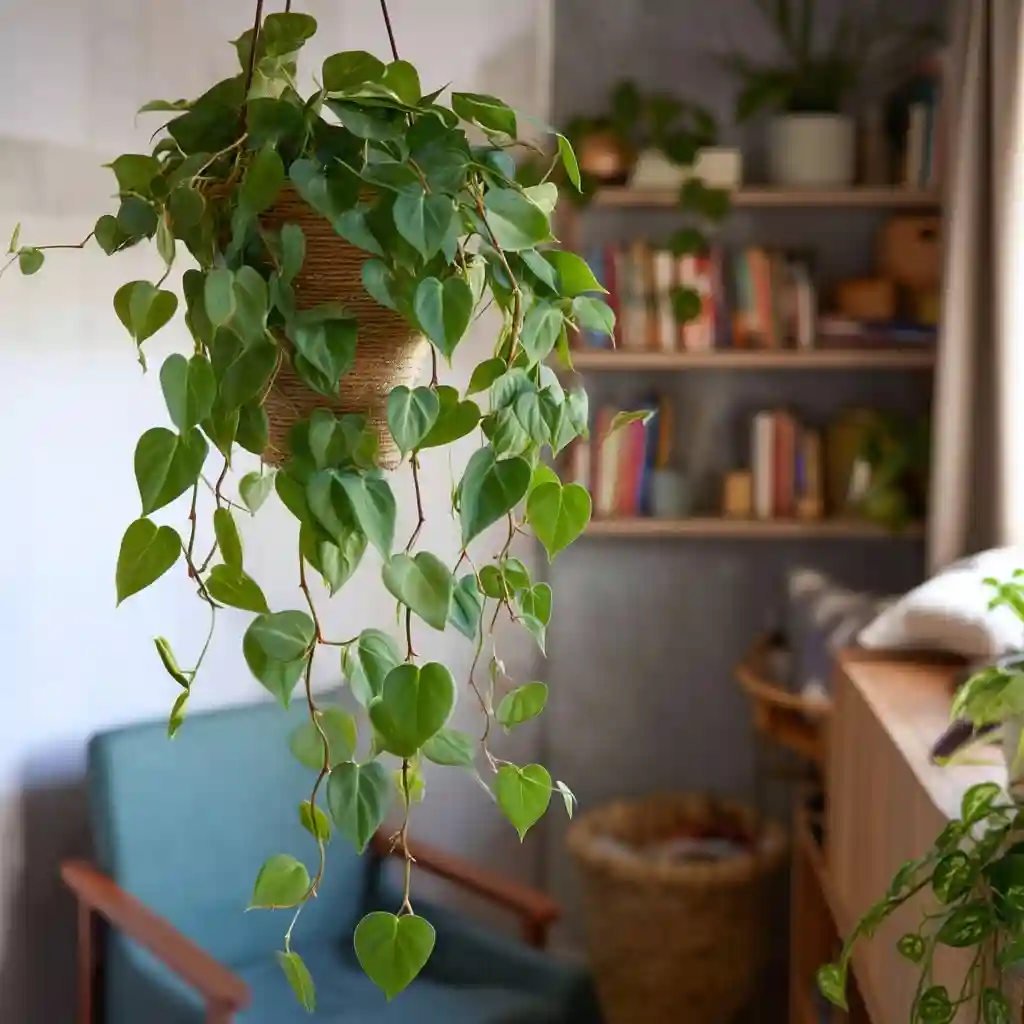
Heartleaf Philodendron (Philodendron hederaceum) is a beloved classic among hanging plants, prized for its lush vines and deep green, heart-shaped leaves. Its trailing growth habit makes it an ideal choice for hanging baskets or high shelves, where its stems can cascade gracefully.
This plant thrives in medium to bright, indirect light but also adapts to lower light, making it a versatile pick for different rooms. Water when the top inch of soil feels dry, and trim back long vines occasionally to encourage a fuller appearance.
It’s also easy to propagate—just place cut stems in water to root new plants, perfect for expanding your indoor garden.
10. Chenille Plant
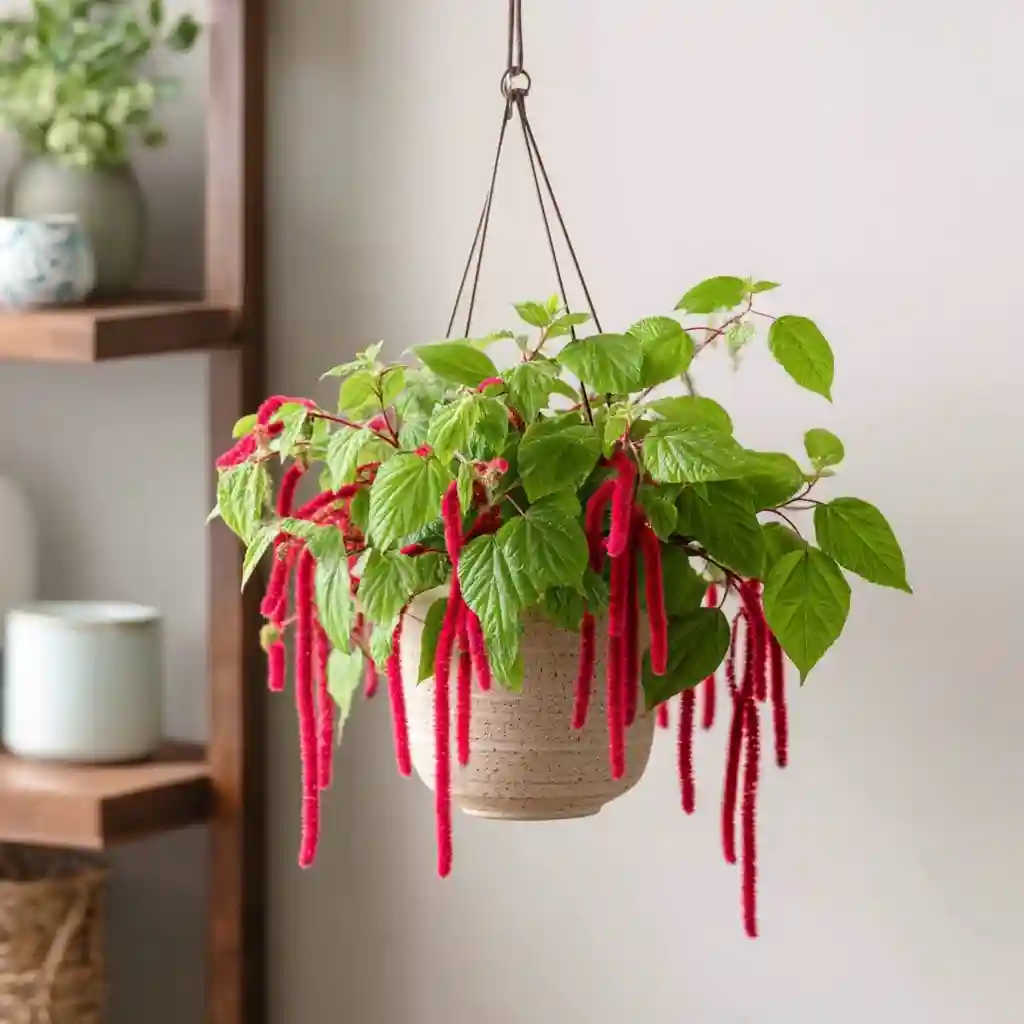
Chenille Plant (Acalypha hispida) is a vibrant choice for those who want hanging plants that truly stand out. Its fuzzy, red blooms dangle like tassels against deep green foliage, giving it the nickname “red-hot cat’s tail.” This bold display makes it an instant conversation piece in any room.
To thrive, chenille plants need plenty of bright, indirect light and regular watering to keep the soil moist. Pruning encourages bushier growth and helps maintain its shape.
With its dramatic flowers and lush leaves, this plant is perfect for adding a splash of color to spaces that need extra warmth and personality.
11. Maidenhair Fern
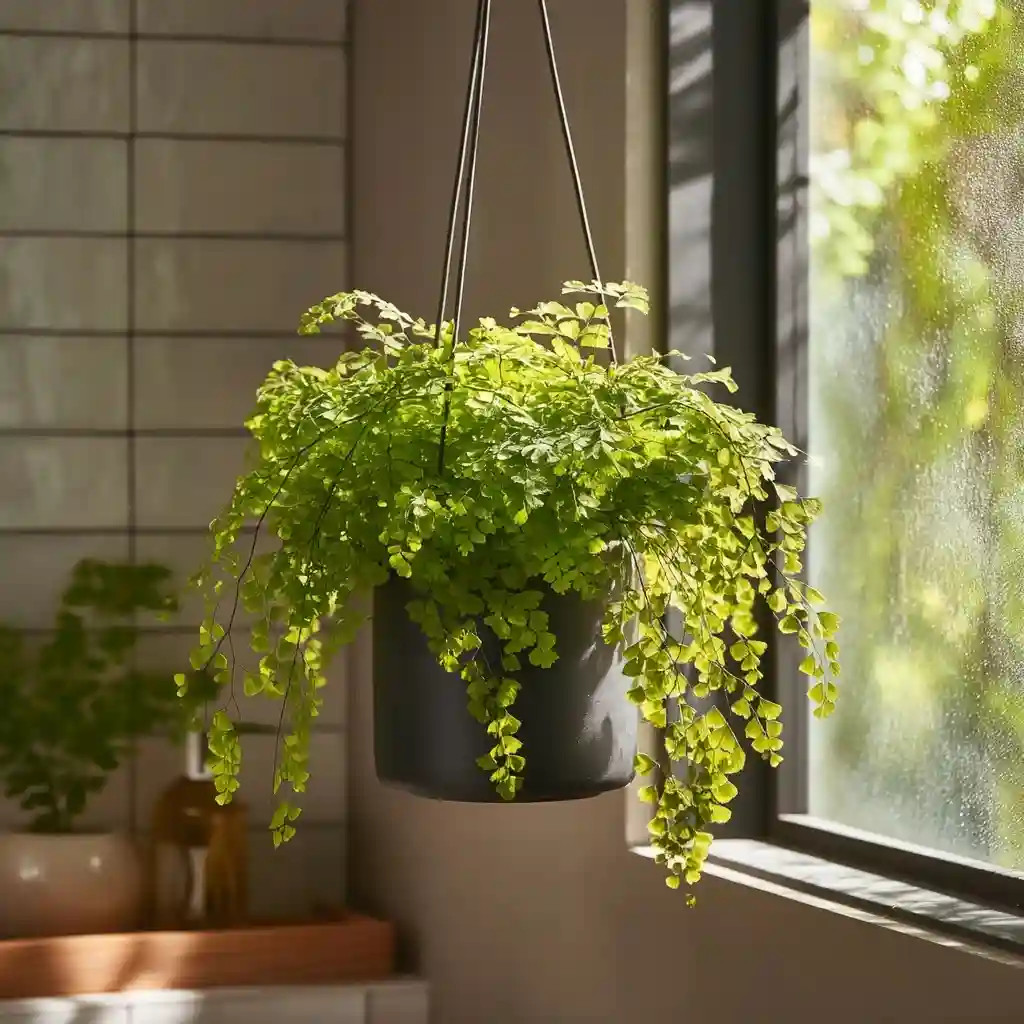
Maidenhair Fern (Adiantum raddianum) is one of the most elegant hanging plants, admired for its delicate, feathery fronds that arch gracefully from thin, black stems. Its airy texture brings a soft, romantic touch to interiors, especially when displayed in a hanging basket.
This fern requires consistent moisture and high humidity, so it’s best suited for bathrooms or spaces where you can mist the leaves often. It prefers bright, indirect light and will quickly show stress if conditions are too dry.
Though a bit more demanding than other houseplants, the maidenhair fern rewards careful care with unmatched beauty and charm.
12. String of Pearls
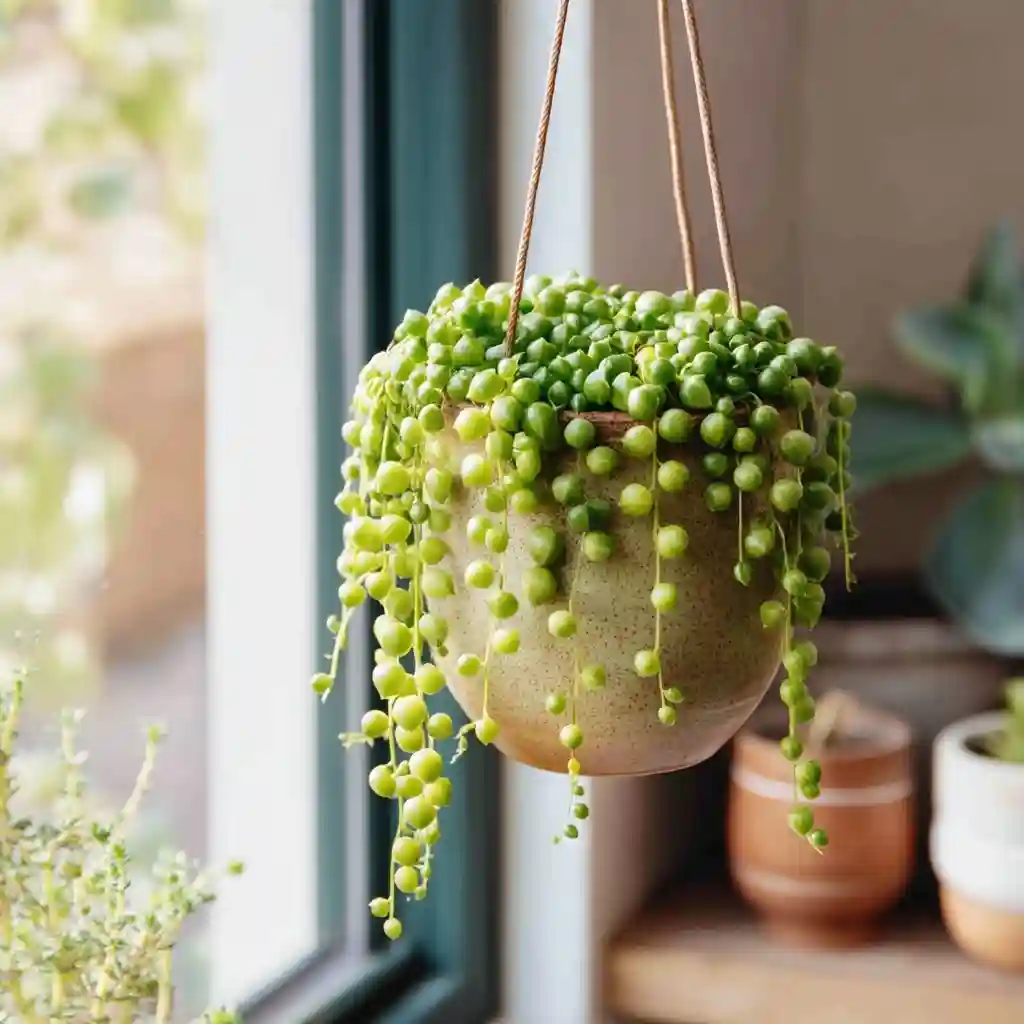
String of Pearls (Senecio rowleyanus) is a striking succulent that lives up to its name. Its bead-like leaves line long, trailing stems, creating the look of green pearls spilling from a basket. This unusual form makes it one of the most eye-catching hanging plants for modern and minimalist interiors.
It thrives in bright, indirect light with a few hours of direct sun each day. Since it stores water in its round leaves, it requires infrequent watering—let the soil dry completely before watering again.
With its whimsical charm and low-maintenance nature, String of Pearls is perfect for adding texture and interest to vertical spaces.
13. String of Hearts
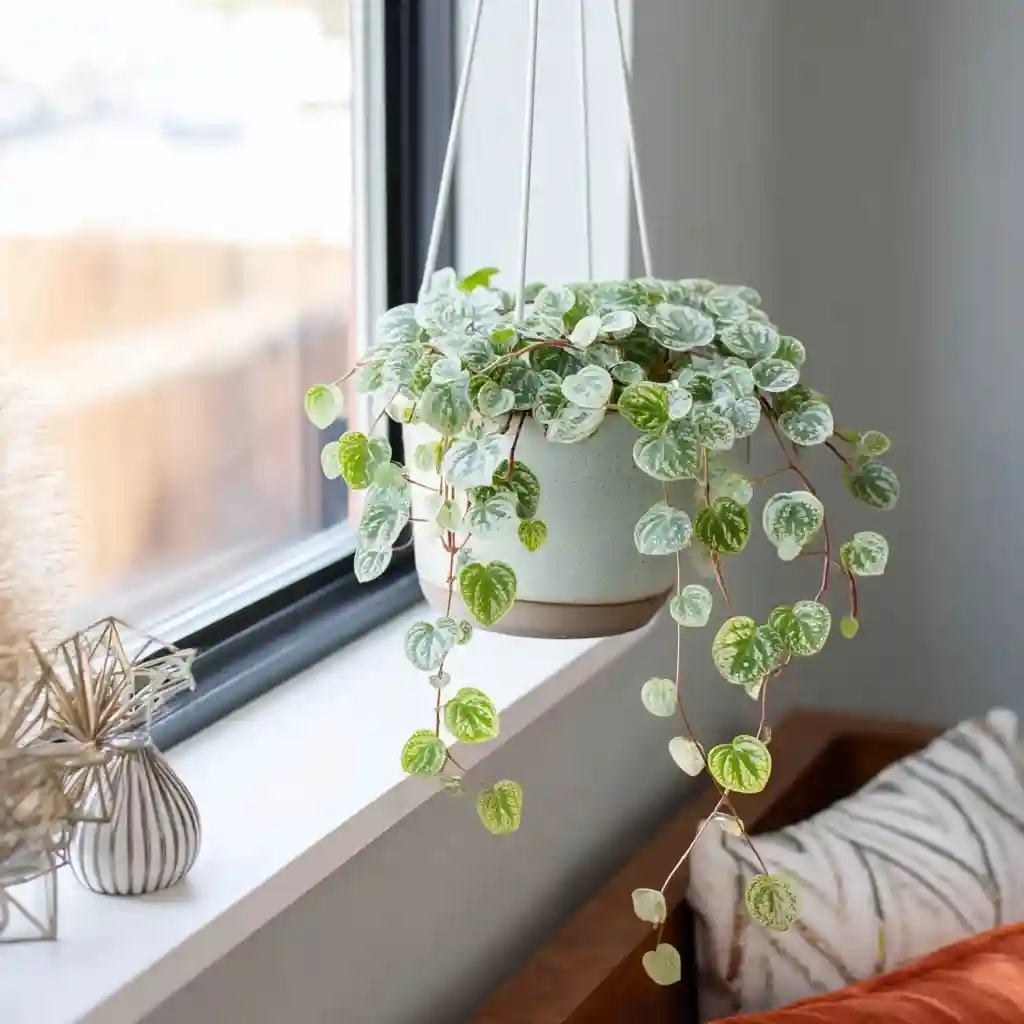
String of Hearts (Ceropegia woodii) is a delicate trailing plant loved for its dainty, heart-shaped leaves. The foliage features silver-green patterns with touches of purple, giving it a romantic, whimsical appearance. When hung high, its thin vines can cascade several feet, creating a graceful curtain of greenery.
This plant thrives in bright, indirect light and prefers well-draining soil. Water sparingly—let the soil dry out between waterings to prevent root rot. With the right care, String of Hearts grows quickly and can be easily propagated from cuttings.
Its charming look makes it a favorite choice for cozy spaces, adding softness and personality to your décor.
14. Peperomia
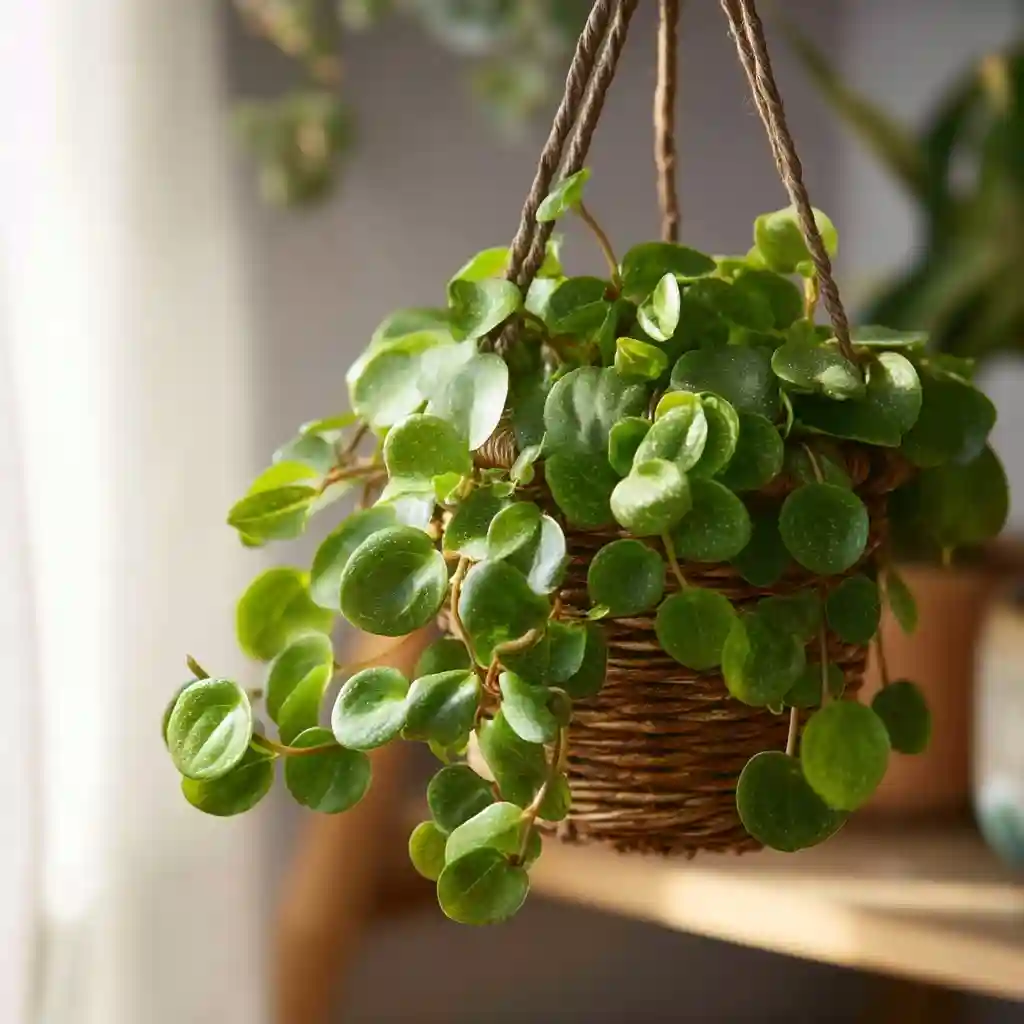
Peperomia is a diverse group of compact, easy-care plants that adapt well as hanging plants. With thick, fleshy leaves that come in a wide range of shapes, textures, and colors, peperomias add variety and visual interest to indoor displays. Some varieties have trailing stems that spill beautifully over the edge of a planter.
These plants thrive in medium to bright, indirect light and prefer well-draining soil. Allow the soil to dry slightly between waterings, as their succulent-like leaves store some moisture.
Peperomia’s manageable size and charming foliage make it a great choice for smaller spaces or as a complement to larger trailing plants.
15. Moth Orchid
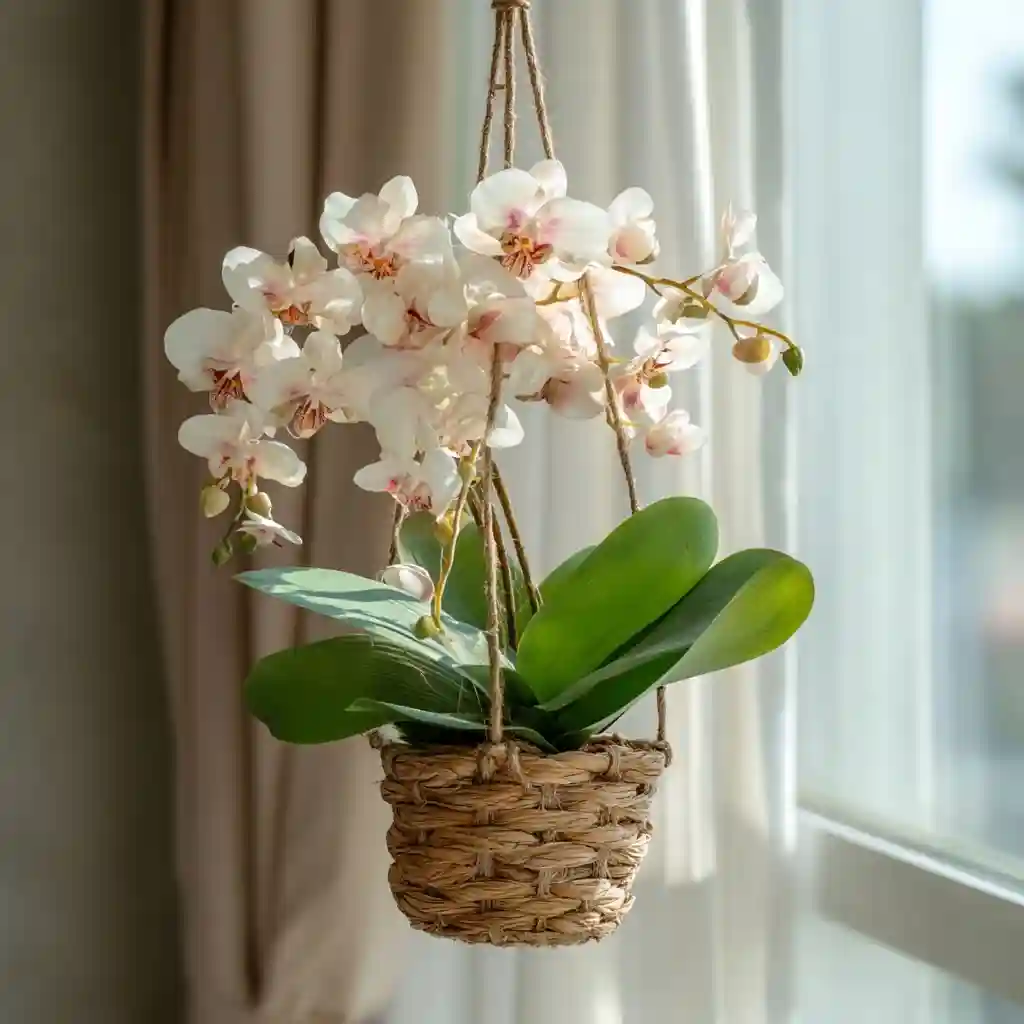
Moth Orchid (Phalaenopsis spp.) brings elegance to the world of hanging plants with its long-lasting, delicate blooms. In their natural environment, these orchids grow on tree branches, which makes them especially well-suited for creative hanging displays at home.
They prefer bright, indirect light and should be watered sparingly—about once a week—while allowing the roots to dry slightly between waterings. Using a well-draining orchid mix helps mimic their natural growing conditions.
With their graceful flowers in shades of white, pink, purple, and yellow, moth orchids add a sophisticated touch to living rooms, bedrooms, or bright hallways.
16. Staghorn Fern

Staghorn Fern (Platycerium bifurcatum) is a bold and unusual addition to hanging plants, instantly recognizable for its broad, antler-like fronds. Unlike typical ferns, it’s often mounted on wooden boards or displayed in hanging kokedama, making it as much a piece of living art as a houseplant.
This fern thrives in bright, indirect light and enjoys a humid environment. Instead of traditional soil, staghorn ferns grow best in a moss-based medium. To water, soak the root ball thoroughly, then allow it to dry before the next watering.
Its dramatic shape and sculptural presence make it an ideal centerpiece for plant lovers seeking something truly unique.
17. Air Plants
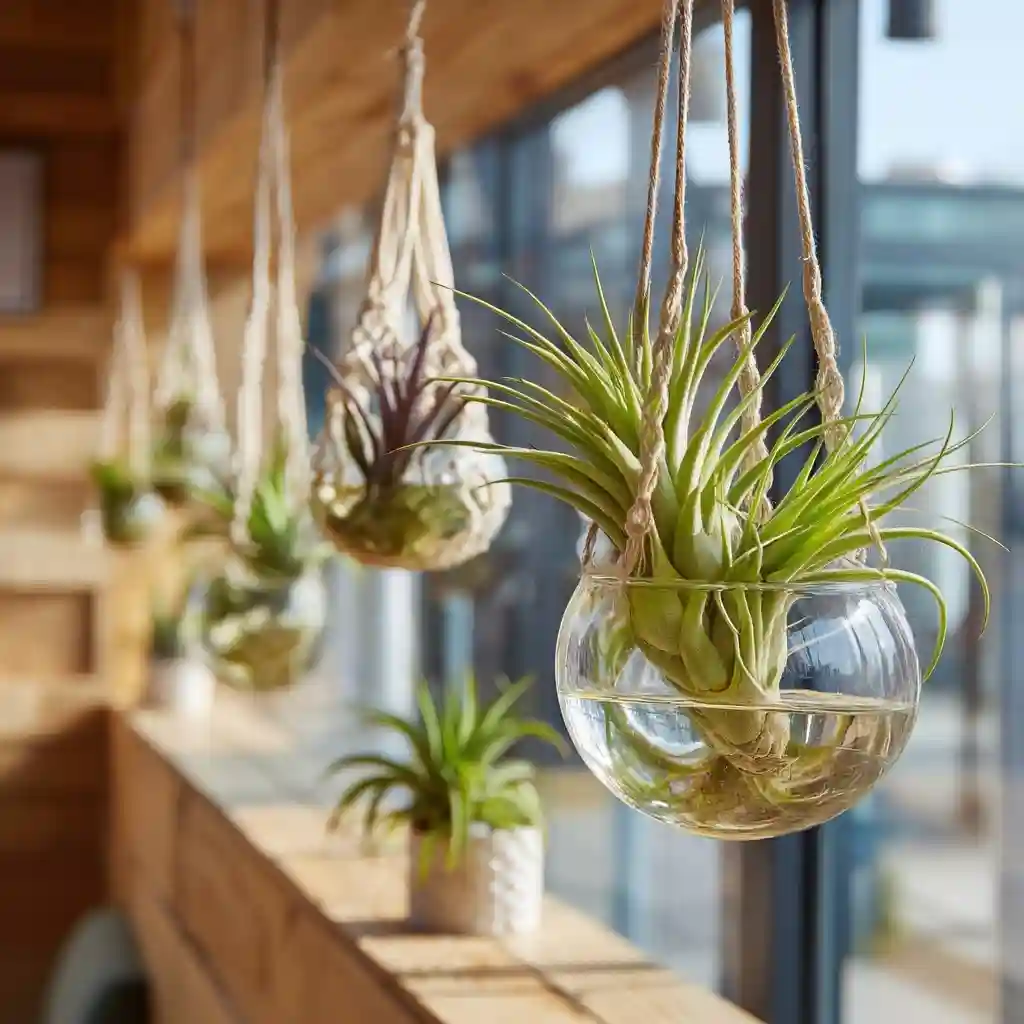
Air Plants (Tillandsia spp.) are some of the most versatile and creative hanging plants because they don’t require soil to grow. Instead, they absorb moisture and nutrients through their leaves, which allows them to thrive in decorative displays like glass terrariums, wall mounts, or macramé holders.
These plants prefer bright, indirect light and need regular misting or a weekly soak in water to stay healthy. Good air circulation is also important, so avoid confining them in closed containers for long periods.
With their wispy shapes and minimal care needs, air plants add a modern, airy touch to vertical spaces while offering endless display possibilities.
18. Satin Pothos
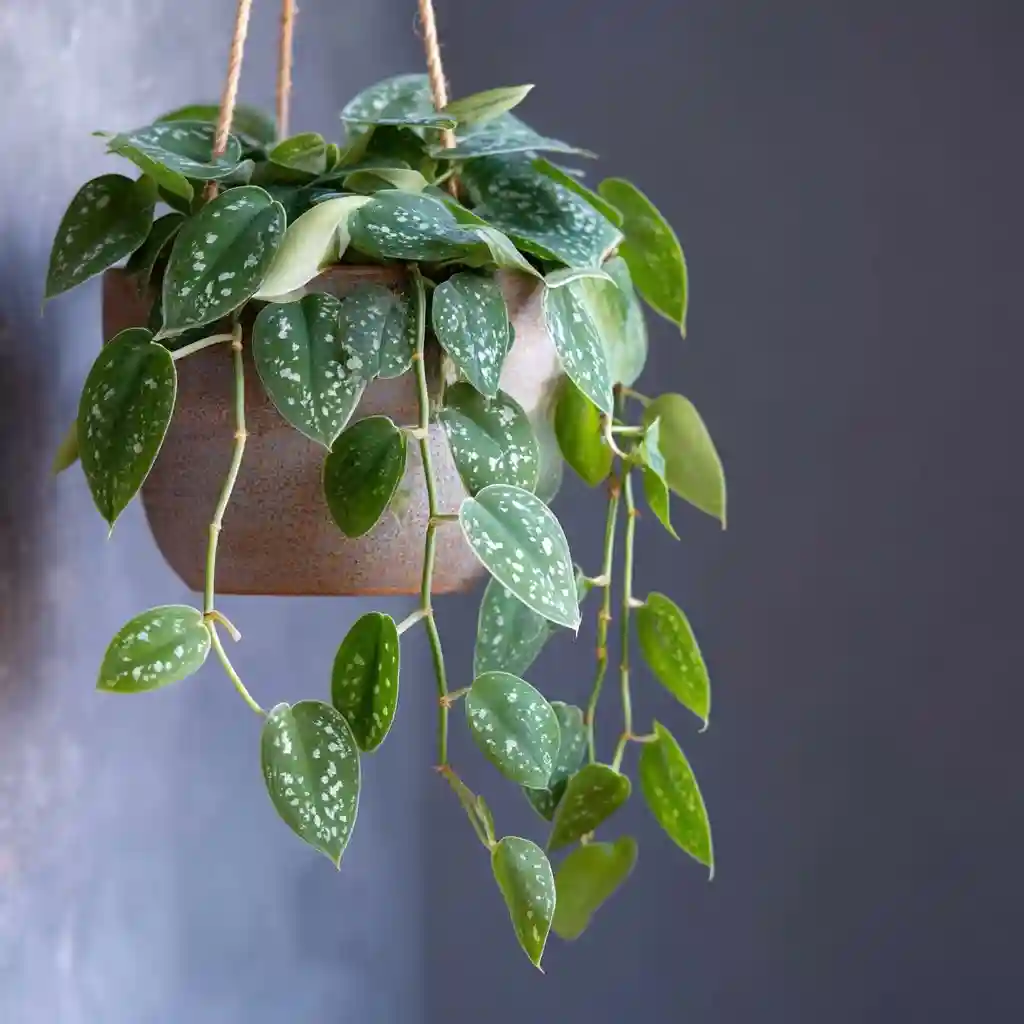
Satin Pothos (Scindapsus pictus) is a close relative of the pothos family but stands out with its velvety, silver-speckled leaves. Its trailing vines shimmer softly in the light, making it one of the most decorative hanging plants for brightening up corners or window spaces.
This plant prefers bright, indirect light but will tolerate medium light conditions. Keep the soil lightly moist, allowing the top inch to dry out between waterings. Direct sunlight should be avoided, as it can scorch the delicate leaves.
With its elegant foliage and low-maintenance nature, Satin Pothos is perfect for adding subtle sparkle to indoor plant collections.
19. Swiss Cheese Vine
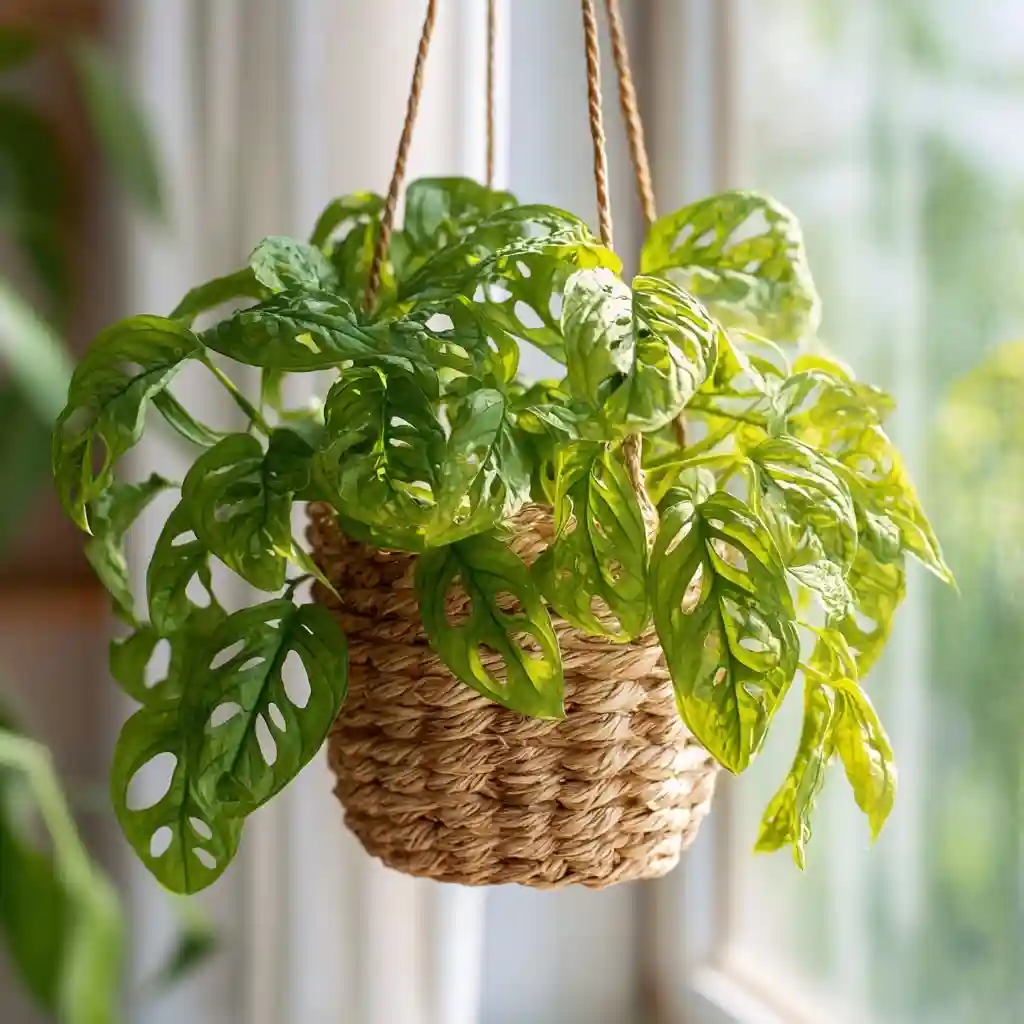
Swiss Cheese Vine (Monstera adansonii) is a fast-growing tropical plant known for its striking, hole-filled leaves. Its unique foliage makes it one of the most eye-catching hanging plants, especially when its vines cascade several feet from a basket or high shelf.
This plant thrives in bright, indirect light and prefers a consistently moist, well-draining potting mix. It also benefits from higher humidity, so placing it near a humidifier or misting regularly helps maintain healthy growth.
With proper care, the Swiss Cheese Vine can grow long, dramatic trails, transforming bare walls or corners into a lush, tropical feature.
20. Inch Plant
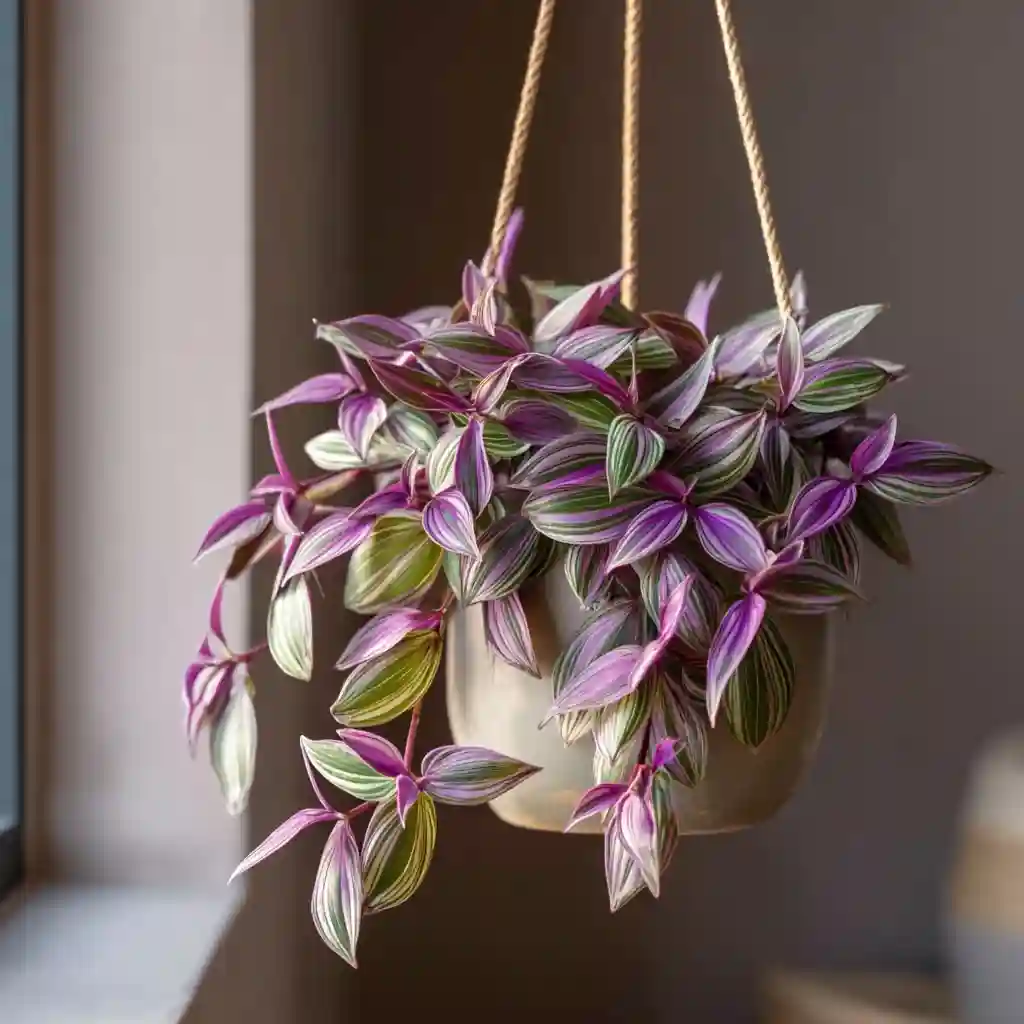
Inch Plant (Tradescantia zebrina), often called wandering dude, is a vibrant and easy-care option among hanging plants. Its leaves display striking stripes of green, silver, and purple, giving it a bold look that brightens up any space. The trailing stems create a colorful cascade that looks stunning in baskets or planters.
This plant grows well in bright, indirect light but can adapt to medium light conditions. Keep the soil slightly moist, allowing the top layer to dry out between waterings. Reduce watering during winter when growth slows.
Fast-growing and easy to propagate, Inch Plant is a rewarding choice for adding vivid color and texture indoors.
21. Grape Ivy
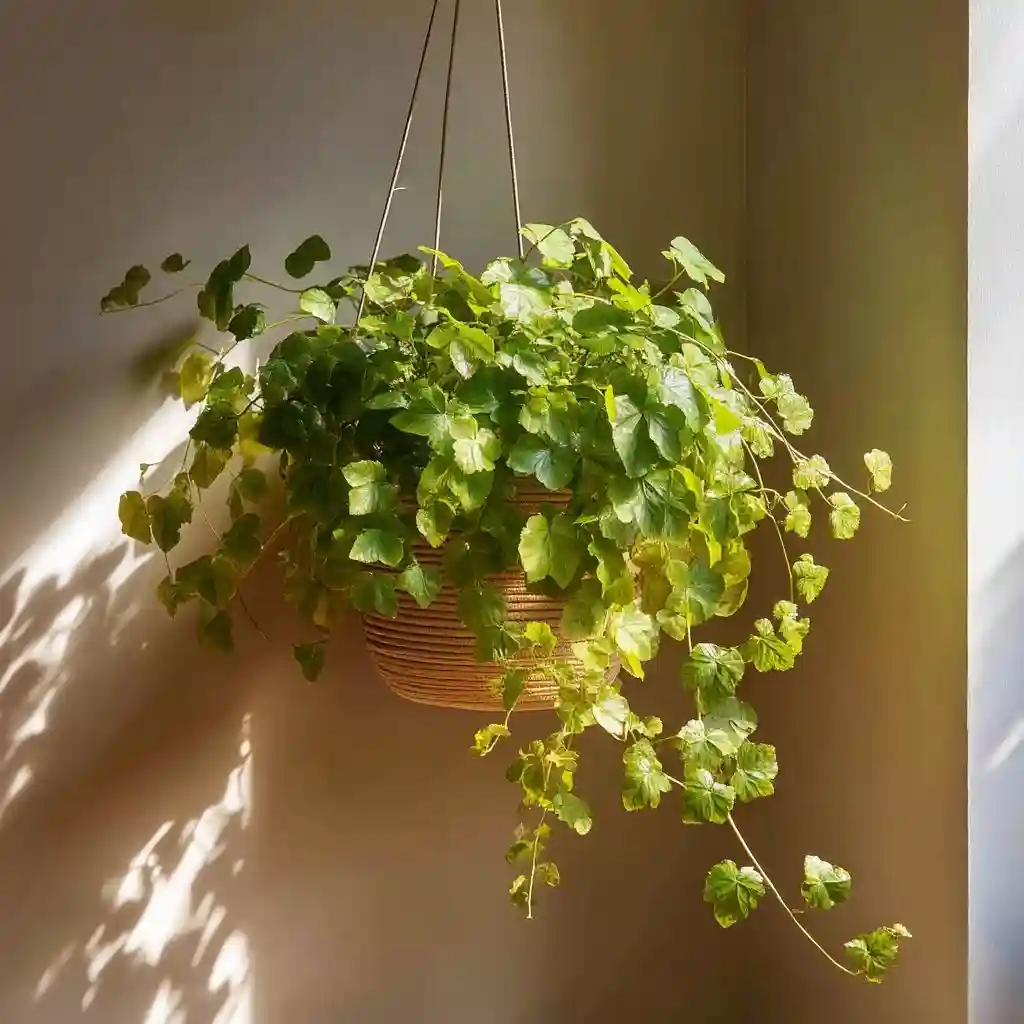
Grape Ivy (Cissus rhombifolia) is a resilient and attractive option for those wanting easy-care hanging plants. Its glossy, vine-like leaves resemble grape foliage, bringing a soft, tropical touch to indoor spaces. When allowed to trail from baskets or shelves, its cascading stems create a relaxed, natural look.
This plant thrives in medium to bright, indirect light and prefers soil that’s kept slightly dry between waterings. It can tolerate a few days without attention, making it ideal for busy households.
With its adaptable nature and elegant foliage, Grape Ivy adds greenery and charm without demanding much effort from its owner.
Conclusion
Hanging plants are more than just décor—they’re a way to transform your living space into a vibrant, soothing retreat. From the delicate leaves of Maidenhair Fern to the bold fronds of Staghorn Fern, there’s a perfect option for every style, lighting condition, and skill level. Whether you’re looking for low-maintenance choices like pothos and spider plants or more dramatic varieties like chenille plant and moth orchids, these trailing beauties make the most of vertical space while bringing nature indoors.
By choosing the right hanging plants for your home, you can enjoy greenery that grows with you—creating a healthier, fresher, and more inviting atmosphere.
🌿 Love gardening inspiration? Follow me on Pinterest for bold plant ideas, tips, and seasonal color!
More Posts
